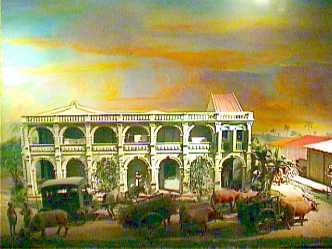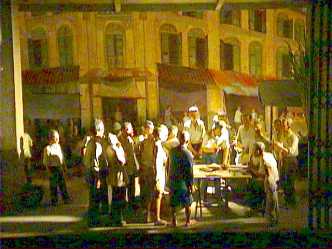|
|
 |
History | Self-Government System
|
|
 The British forces came back in September 1945 and Singapore came under the
British Military Administration once more. However their
rights to rule were now questionable. Toward the end of March 1946, the period of
military administration ended and the Straits Settlement was dissolved.
The British forces came back in September 1945 and Singapore came under the
British Military Administration once more. However their
rights to rule were now questionable. Toward the end of March 1946, the period of
military administration ended and the Straits Settlement was dissolved.
On the 1st of April 1946, Singapore became a Crown
Colony. Penang and
Malacca became part of the Malayan Union. The Singapore after the Japanese
Occupation was very different than before. The Governor had an advisory council
of officials and with the constitution powers he nominated non-officials.
On July 1947, the advisory council evolved into the separate Executive and
Legislative Councils. The Governor retained the control over the colony but
there was a stipulation to elect the six members to the Legislative Council.
It was through popular vote.
The Malayan Union was known as the Federation of Malaya in 1948 and on the
20th of March 1948, Singapore's first election was held. In the mid
of 1948, a state of emergency was declared when the Communist Party of Malaya
tried to control Malaya and Singapore by force. It lasted for 12 years.
By the end of 1953, the British government appointed a commissioner, Sir George
Rendel, to review on Singapore's constitutional position and gave suggestions
for any changes. The government accepted the proposals made by Rendel and it
gave Singapore a greater measure of self-government.
 The election in 1955 was the first lively political contest in Singapore's
history. The Labour Front won 10 seats, The Peoples Action Party (PAP), which
had 4 candidates in the election won 3 seats. On the 6thApril 1955,
David Marshall became the Singapore's first Chief Minister with a temporary
government made up of his own Labour Front, the United Malays National
Organization and the Malayan Chinese Association.
The election in 1955 was the first lively political contest in Singapore's
history. The Labour Front won 10 seats, The Peoples Action Party (PAP), which
had 4 candidates in the election won 3 seats. On the 6thApril 1955,
David Marshall became the Singapore's first Chief Minister with a temporary
government made up of his own Labour Front, the United Malays National
Organization and the Malayan Chinese Association.
After being the Chief Minister for a year, David Marshall resigned the position
after failing the negotiation in London on attaining full internal
self-government. Lim Yew Hock took over the tasks of the Chief Minister.
After learning the experience from David Marshall, Lim Yew Hock successfully
negotiated the main terms of a new Singapore Constitution. The constitution
agreement was signed in London on 28th of March 1958.
Self-government was attained in 1959 and on the same year, Singapore's first
general election was held. This was to choose 51 representatives to the first
fully elected Legislative Assembly. PAP won 43 seats, gaining 53.4% of the total
votes. On the 3rd of June 1959, Singapore brought into force the
self-governing state by the proclamation of the Governor, Sir William Goode,
who became the first Yang di-Pertuan Negara (Head of State). Two days later,
Lee Kuan Yew became the Prime Minister of Singapore. PAP, together with the
communists, fought with the British colonialism. It was not an easy alliance of
the PAP and the communists as they both had their own objective to achieve. PAP
wanted to obtain full independence for Singapore as part of a non-communist
Malaya whereas the communists worked towards the communists takeover.
The alliance did not last long and the tension between the two factions worsened.
The communists formed a new political party known as the Barisan Sosialis.
Malayans agreed to allow Singapore to merge with the Malaya as part of a larger
federation.
|
1945 - 1955 Political Awakening
|
|
The next phase saw the exploitation of racial sensitivities by the communists to further their political goals and the religious tension surrounding the Maria Hertogh riots.
This was also a period where our country achieved limited self-government through the partially elected Legislative Assembly and where support for political parties were rallied along racial lines.
|

|
Political Awakening - Movie
Description
and Movie - Courtesy of Government of Singapore (Singapore
Infomap)
|
|
On the 27th of May 1961, Malayan Prime Minister, Tunku Abdul Rahman,
proposed closer political and economic co-operation between the Federation of
Malaya, Singapore, Sarawak, North Borneo and Brunei in the form of a merger.
Main terms of the merger were to have a main government responsible for defense,
foreign affairs and internal security, but matters regarding to education and
labour would be responsible by their own country.
On the 16th of September 1963, Malaysia was formed which consisted of
the Federation of Malaya, Singapore, Sarawak and North Borneo (now known as Sabah).
Brunei opted out. Indonesia and the Philippines opposed the merger.
|
1955 - 1961 Communist Threat
|

|
During this period, we see how influential communist factions incited bloody riots among bus workers in the 1955 Hock Lee Bus Riots, and how pro-communists within the PAP also caused a sharp split in the party when they opposed merger with the Federation of Malaya.
|
Communist Threat
- Movie
Description
and Movie - Courtesy of Government of Singapore (Singapore
Infomap)
|
|
Japanese Occupation
|
Gaining Independence
|
|
|
|
|